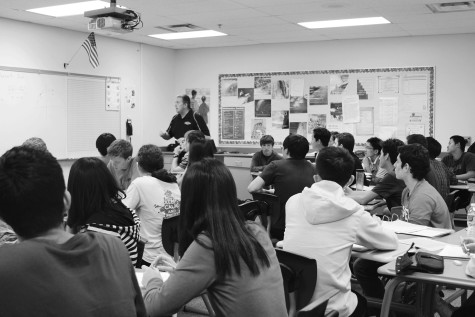Bigger is not always better

As the voices of nearly 30 classmates permeate the room, I cannot think or learn to the best of my ability, leaving the Google Doc on my computer screen glowing with an alarming blankness.
In classes like these, where there are no empty desks in sight, I feel utterly unproductive. My thoughts are stifled by the overcrowded room, stealing away my ideas.
But not all of my classes are overpopulated.
In small classes of 20 students or less, my thoughts are liberated. The classroom is no longer teeming with people, and the conversations of my peers reflect their engagement in the classroom discussions.
Through the rich discussions, smaller classes make loud statements and leave large impacts. These impacts are ones that large classes do not leave.
Heavily populated classes are sometimes necessary. The student-to-teacher ratio, student enrollment in each class and the number of blocks that each class is available make it difficult to avoid large class sizes. Unless the student-to-teacher ratio can be significantly decreased, large classes are not going to disappear, but they can be improved.
According to a study published by the National Educational Policy Center at the University of Colorado at Boulder, students saw vast improvements in their academic performance and did strikingly better on tests in a small learning environment.
Smaller class sizes are especially effective because, unlike in large classes, students do not feel as though they are being packed into a room like sardines. I, for one, relish in the opportunity to move around a classroom freely, without tripping over my fellow classmates and their belongings.
Students in large classes also have less opportunities to participate in discussions. They face pressure to say something of value before time expires. When there are too many people and too many ideas present, these discussions serve to penalize introverted students like myself.
According to the study, students in small classes spend more time on task. This is due, in part, to the ability of teachers to devote more time to classroom instruction, especially because they do not have to waste valuable time focusing on managing a large class.
It is possible, however, for teachers to make students in overpopulated classes feel as though they are getting the elevated level of individual attention typical of a small class. If large classes are arranged in an organized manner and are divided for discussions, then teachers can treat their overpopulated classes as if they are not that populated at all.
The illusion of creating a small learning environment in a classroom that could otherwise be overwhelming is the most effective way for a teacher to confront overpopulated classes. It does not eliminate the problem, but it does serve as an effective coping method.
This holds true in my well-organized classes where, unlike in other, overcrowded environments, I am able to transform the blank Google Doc on my computer screen into a well-worded reflection of my learning. When the class size is small, or at least feels that way, I can finally be productive.
After all, bigger is not always better.

